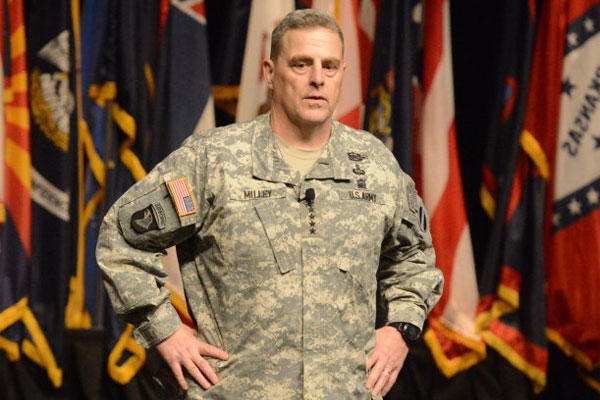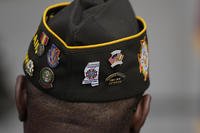The Pentagon chief today named Gen. Mark Milley – a leader with a strong background in light infantry and Special Forces – to replace Gen. Raymond Odierno as the Army's next chief of staff.
Flanked by Milley and Joint Chiefs of Staff chair Gen. Martin Dempsey, Defense Secretary Ash Carter announced the nomination of Milley to be the 39th chief of staff of the Army.
President Obama has accepted the nomination, referring to Milley as a "warrior and a statesmen."
"He not only has plenty of operational and joint experience in Afghanistan, in Iraq and on the Joint staff, but he also has the intellect and vision to feed change throughout the Army," Carter said.
Carter spoke of Odierno's performance over the last four years, calling him "a tremendous leader."
The past four years have been "critical for our military and our country, marked by an every changing security environment and by persistent budget hurdles," Carter said, referring to Odierno's leadership.
Milley graduated and received his commission from Princeton University in 1980.
He has served in the 82d Airborne Division and the 5th Special Forces Group at Fort Bragg, N.C., the 7th Infantry Division at Fort Ord, Calif., the 10th Mountain Division at Fort Drum, N.Y., the 2d Infantry Division in Korea, the Joint Readiness Center at Fort Polk, La., the 25th Infantry Division at Schofield Barracks, Hawaii, and the 101st Airborne (Air Assault) at Fort Campbell, Ky.
Milley has commanded the 1st Battalion, 506th Infantry in Korea, the 2d Brigade, 10th Mountain Division, the 10th Mountain Division at Fort Drum, and the III Corps at Fort Hood, Texas.
Additionally, he has served on the Operations Staff of the Joint Staff and as a Military Assistant to the Secretary of Defense in the Pentagon. He was also commanding general of III Corps and Fort Hood where he deployed as the C.G. of ISAF Joint Command and Deputy Commanding General, United States Forces-Afghanistan.
Millie is authorized to wear the Combat Infantryman Badge with star, Expert Infantryman Badge, Master Parachutist Badge, Scuba Diver Badge, Ranger Tab, and Special Forces Tab.
"When he was in Afghanistan as commanding general of ISAF joint command, I had a lot of opportunity to observe Mark on the ground leading our coalition allies and partners and helping the Afghan people prepare to take responsibility for their own security," Carter said.
"Mark and I flew to Iraq the day after an attack on the U.S. consulate there, and I saw Mark take command of the scene and stand with our people there I was impressed by his candor and good judgment, and I knew right away that he had more to offer the United States Army."
Recently, Milley was put in charge of reviewing the investigation into Sgt. Bowe Bergdahl, who was charged with multiple counts to include desertion.
Odierno also praised Milley as an experienced leader.
"The President has chosen a phenomenal leader in General Mark Milley as the 39th Chief of Staff of the Army," Odierno said in a written statement.
"General Milley is an experienced, combat-tested, and caring leader. I have known General Milley for many years, have served with him in Iraq and watched him in Afghanistan. I am confident that he is the right leader to lead our Army into the future."
Odierno's Term Ending
Odierno's time as Army chief was marked by many challenges. He has struggled to maintain Army readiness in the face of systematic defense-spending cuts known as sequestration.
He's had to orchestrate a massive restructuring of the active force that has involved cutting about a dozen brigade combat teams to get the force down to 490,000 by 2016.
Not all of his decisions have been popular. He has faced significant push-back from the National Guard for his decision to transfer the Guard's AH-64 Apache gunships to the active force as part of the Army's Aviation Restructuring Initiative.
Odierno also killed the Army's top modernization effort last year. He was a strong supporter of the effort to replace the Bradley fighting vehicle with the new Ground Combat Vehicle, but the Army couldn't afford a fleet of expensive GCVs in the current budget climate.
Before becoming chief of staff, Odierno spent almost a decade of his career in Iraq. Troops often referred to the 6-foot, 6-inch general as the "soldier's soldier."
He led the 4th Infantry Division in the 2003 invasion before going on to later command Multi-National Corps-Iraq from 2006 to 2008. Odierno returned to Iraq after a brief stint as Army vice chief of staff to succeed Petraeus in September 2008 as Multi-National Force-Iraq commander.
The career field artillery officer's time in Iraq was not free from criticism. Some critics inside and outside the Army described his command the 4th Infantry's Division after the invasion as heavy-handed.
Some of Odierno's strategy involved conducting widespread cordon and search operations that had Americans bursting into tens of thousands of Iraqi homes and detaining tens of thousands of Iraqi civilians. Many turned out to be innocent and wound up so angered by the experience that they either supported or joined the insurgency, critics maintain.
To be fair, Odierno's unit was operating in the Sunni Triangle, an extremely violent area north of Baghdad which included Tikrit, Saddam Hussein's home town.
Odierno took those critiques to heart and returned to Iraq in 2006 with a new outlook on how the U.S. could retake control of a country spiraling into an uncontrollable wave of violence and potential civil war. Odierno was also one of the troop surge's earliest champions, even when most of the Army brass worried that it would only mean more casualties.
"There will be plenty of time in the months ahead for proper tributes and farewells, but for now let me just say that President Obama, Chairman Dempsey and I could not have been better served," Carter said.
-- Matthew Cox can be reached at matthew.cox@military.com
Don't Miss a Single Military.com Story
To read the full article and get exclusive benefits, sign up today.
It’s FREE
Why am I seeing this? Visit our FAQs



























